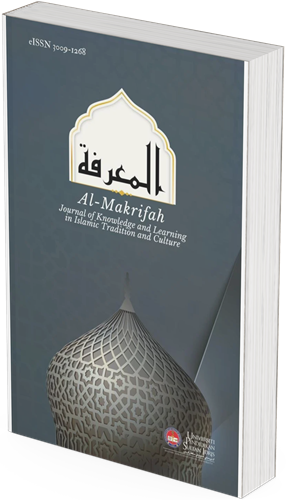The Implementation of Integrated Islamic Education (IIE) in Malaysian Islamic Religious Secondary Schools from Education Administrators’ Perspectives
DOI:
https://doi.org/10.37134/almakrifah.vol2.2.7.2024Keywords:
Integrated Islamic education, Islamic school, Malaysian Islamic education, integrated educationAbstract
This study is based on the premise that there is a need for an integrated Islamic education (IIE) curriculum that could develop the whole person of Muslim children. It examines the school administrators and educational officers’ views on the key aspects related to the effectiveness of the implementation of the IIE curriculum, such as the understanding of the IIE’s concept and the teaching and assessment techniques of IIE. The study is using qualitative method; it employed interviews with 12 respondents from the National Religious Secondary School (SMKA) and Selangor Islamic Religious Department (JAIS) schools and two educational officers. The findings identified that Islamic education school administrators have positive attitudes towards IIE, have adequate knowledge of the integrated concept of Islamic education and highly encourage their teachers to use various pedagogical methods in teaching IIE. The findings also indicate that the schools have implemented a systematic assessment for students’ academic achievement, but only some schools have assessed the behavioural aspects of their students. Despite these positive results, the study reveals a few problems in implementing IIE, such as exam-oriented trends and the inadequacy of professionally certified teachers in some schools, which could hinder its effectiveness.
Downloads
References
Ab. Halim, T. (2007). Islamic Education Teachers' Perceptions of the Teaching of Akhlāq in Malaysian Secondary Schools. Journal of Moral Education, 36: 3, 371-386.
Abdul Rahim, H & Azharul Nizam, Z. (2012). Konsep Bersepadu serta Penerapan Nilai-Nilai Murni dalam Pengajaran Matematik Menengah Rendah. http://eprints.utm.my/10466/1/. Retrieved on 8 January 2016.
Arbaiyah M. N. (2008). The Development of Islamic Education in Kelantan. Journal of Malaysia in History, No.36, 68-83.
Che Noraini, H. & Hasan, L. (2008). Islamic Religious Curriculum in Muslim Countries: The Experiences of Indonesia and Malaysia. Bulletin of Education & Research, 30: 1, 1-19.
Badlihisham, M.N. (2010). Pendidikan dalam Gerakan Islam di Malaysia: Satu Tinjauan. Journal of Islamic and Arabic Education, 2 (1), 1-12.
Hatifah, Y. (2000). Pendidikan Syariah Islamiyyah: Satu Kajian tentang Permasalahan dalam Pengajaran di Sekolah Agama dan Harian di Selangor. Unpublished Master Dissertation for National University of Malaysia (UKM).
Ibrahim, H. (2006). An Integrated Concept of Islamic Education: A Study on Islamic Education in Muslim Religious Schools in Selangor, Malaysia. Unpublished PhD. Thesis. University of Abertay Dundee.
Khairul Azmi, J (2011). Pendidikan Islam: Cabaran di Alaf Baru. Seminar Pendidikan Islam. Kuala Kangsar: Madrasah Idrisiah.
Lawton, D. and Gordon, P. (1996). Dictionary of Education. London: Hodder and Stoughton.
McBer, H. (2000). A Model of Teacher Effectiveness in Report of Research into Teacher Effectiveness. Unpublished Report for the Department for Education and Employment.
Ministry of Education, Malaysia (2012a). Malaysia Education Blueprint 2013-2025. Kuala Lumpur: Ministry of Education.
Ministry of Education, Malaysia (2001). Education in Malaysia: A Journey to Excellence. Kuala Lumpur: Ministry of Education.
Ministry of Education, Malaysia (2012b). Sekolah Menengah Kebangsaan Agama (SMKA) Online. http://www.moe.gov.my/my/sabk-smka. Retrieved on 25 December 2015.
Ministry of Education, Malaysia (1992). Kajian Pengajaran dan Pembelajaran Pendidikan Islam di Sekolah-sekolah Menengah di Malaysia. A Report for Ministry of Education, Malaysia.
Mohd. Nur, M. (1989). Perception of Social Change in Contemporary Malaysia: A Critical Analysis of ABIM's Role and its Impact among Muslim Youth. Unpublished Ph. D. dissertation for Temple University.
Patton, M. Q. (1987). How to Use Qualitative Methods in Evaluation. London: Sage Publication.
Rahimah, E, Rosnani, H. & Yuslaini, Y (2013). Islamic Integrated Curriculum (IIC) for the Transformation of Islamic Education in Malaysia. Seminar Majlis Dekan Pendidikan IPTA. Gombak: Institute of Education IIUM.
Rahimah, E, Wan Ismail, W.A. & Normila, N. (2013). Amalan Kurikulum Bersepadu dan Transformasi Pendidikan di Malaysia. Seminar Majlis Dekan Pendidikan IPTA. Gombak: Institute of Education IIUM.
Rosnani, H. (1996). Educational dualism in Malaysia: Implications for theory and practice. Kuala Lumpur: Oxford University Press.
Tengku Sarina Aini, T. K. (2014). Teaching Paradigms: An Analysis of Traditional and Student-Centred Approaches. Journal of Usuluddin, 40, 199-218.
Downloads
Published
How to Cite
Issue
Section
License
Copyright (c) 2024 Ibrahim Hashim, Sulaiman Dorloh

This work is licensed under a Creative Commons Attribution-NonCommercial-ShareAlike 4.0 International License.





